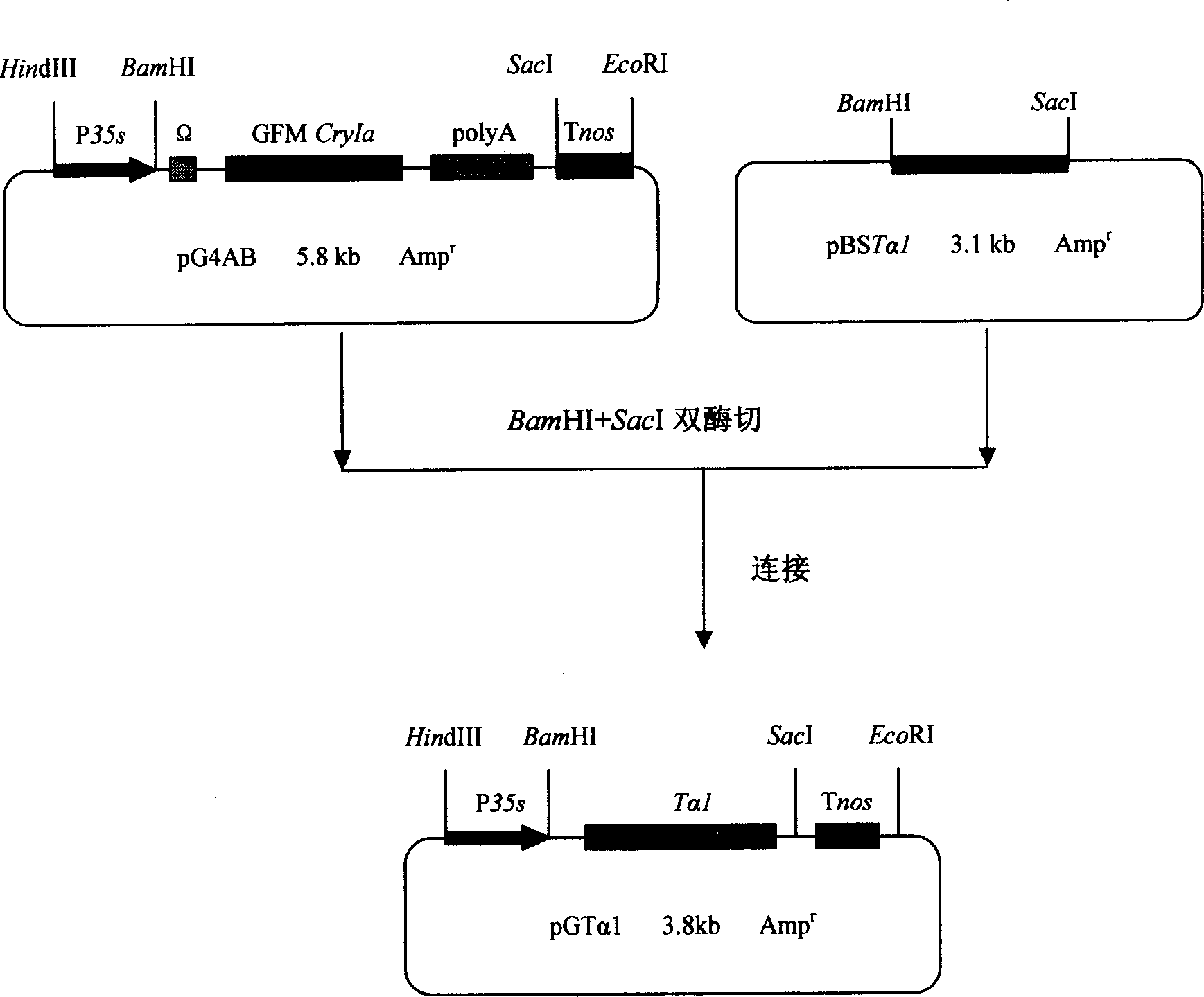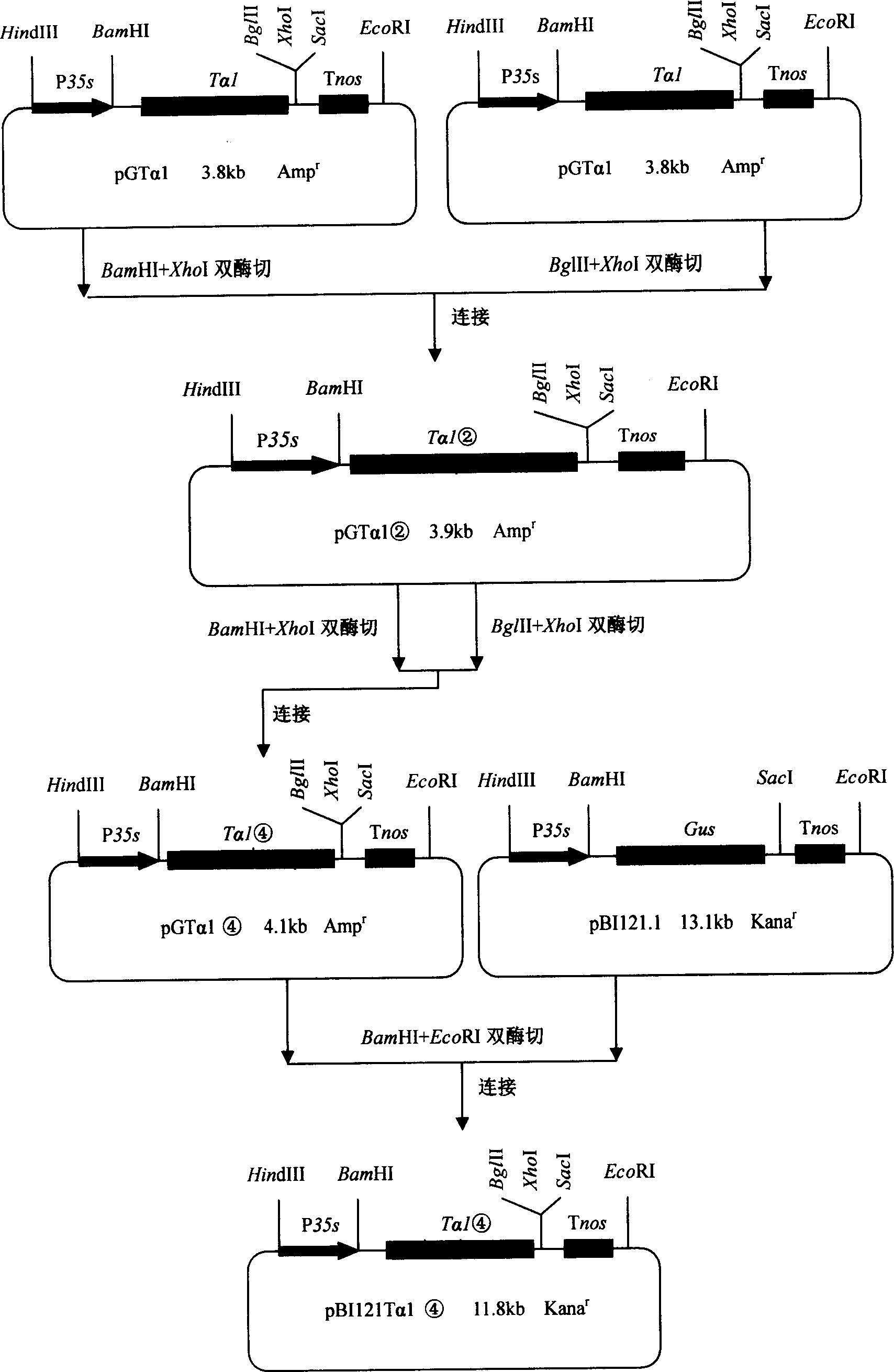Method for producing human thymosin alphal utilizing transgenic tomato
A technology of thymosin and human thymus, which is applied in the fields of biochemical equipment and methods, genetic engineering, plant genetic improvement, etc., can solve the problems of antigenicity of impurities, difficult to be widely used, and small clinical efficacy, so as to save transportation, The effect of avoiding cross infection and reducing production costs
- Summary
- Abstract
- Description
- Claims
- Application Information
AI Technical Summary
Problems solved by technology
Method used
Image
Examples
Embodiment 1
[0030] Embodiment 1 Artificial synthesis of human Tα1 gene
[0031] According to the plant preference codon provided by Murray E.E. et al. (see Table 1), the nucleotide sequence of the human Tα1 gene reported by William et al. (1986) was modified, and a restriction enzyme site was designed upstream of the Tα1 gene BamH I, the enterokinase recognition site GATGA TGATGATAAG and BglII, Xho I and Sac I were designed downstream. Then divide the dsDNA into 5 fragments and synthesize them separately:
[0032] ①5'G AGCTCGAGTT AAGATCTCTT ATCATCATCA TCGTTCTCAG CCTCCTCAAC3'(51b);
[0033] ②5'AACCTCCTTCTTCTCCTTAA GATCCTTAGT AGTAATCTCA GAAGAAGTATCAACAGCAGC 3'(60b);
[0034] ③5'ATCAGACATT GTGGATCC 3'(18b);
[0035] ④ 3'C TCGAGCTCAA TTCTAGAGAA TAGTAGTAGT AGCAAGAGTC GGAGGAGTTGTTGGAGGAAG AAGAGGAATT 5'(71b);
[0036] ⑤ 3' CTAGGAATCA TCATTAGAGT CTTTCTCATA GTTGTCGTCG TAGTCTGTAACACCTAGG 5' (58b).
[0037] serial number
a
serial number
a
...
Embodiment 2
[0074] Example 2 Construction of plant expression vector pBI121Tα1④
[0075] When the Tα1 gene was synthesized, the BamHI site was designed on the left side, and the enterokinase recognition site GATGATGATG ATAAG and BglII and XhoI recognition sequences were designed on the right side. BamHI and BglII are isocaudiners, they recognize different nucleotide sequences, but produce the same sticky ends, and these two sticky ends can no longer be recognized by these two enzymes after ligation, so we can use isocaudiners Gene concatenation. After concatenation, adjacent genes are separated by enterokinase sites, and after the concatenated thymosin protein is eaten, it will be decomposed into monomeric thymosin protein in the intestine through the action of enterokinase to play a role.
[0076] The construction process of the plant expression vector pBI121 Tα1④ is as follows: Figure 4 shown. First, the Tα1 gene was excised from the plasmid pBSTα1 with BamHI and SacI, and cloned in...
Embodiment 3
[0078] Example 3 Transformation of plant expression vector into Agrobacterium tumefaciens
[0079] 1. Preparation of Agrobacterium Competent Cells:
[0080] 1) Pick a single colony of Agrobacterium strain LBA4404 and inoculate it in 5 ml of YEB liquid medium (containing 100 μg / ml streptomycin), and cultivate overnight at 28° C. and 250 rpm;
[0081] 2) Take 2ml of the culture and transfer it into 50ml of YEB liquid medium, and continue to cultivate until the OD value is about 0.6;
[0082] 3) Transfer the bacterial solution to a sterile centrifuge tube, bathe in ice for 30 minutes, and centrifuge at 5000rpm for 5 minutes;
[0083] 4) with 1.7ml 20mM sterile CaCl 2 Resuspend the bacteria, add 300 μl sterile glycerol, mix well, dispense 200 μl per tube into sterile 1.5ml microcentrifuge tubes, and store at -70°C for later use.
[0084] 2. Transformation of Agrobacterium tumefaciens:
[0085] 1) Add 2 μg of recombinant plasmid DNA to 200 μl LBA4404 competent cells, bathe in i...
PUM
 Login to View More
Login to View More Abstract
Description
Claims
Application Information
 Login to View More
Login to View More - R&D
- Intellectual Property
- Life Sciences
- Materials
- Tech Scout
- Unparalleled Data Quality
- Higher Quality Content
- 60% Fewer Hallucinations
Browse by: Latest US Patents, China's latest patents, Technical Efficacy Thesaurus, Application Domain, Technology Topic, Popular Technical Reports.
© 2025 PatSnap. All rights reserved.Legal|Privacy policy|Modern Slavery Act Transparency Statement|Sitemap|About US| Contact US: help@patsnap.com



